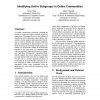Free Online Productivity Tools
i2Speak
i2Symbol
i2OCR
iTex2Img
iWeb2Print
iWeb2Shot
i2Type
iPdf2Split
iPdf2Merge
i2Bopomofo
i2Arabic
i2Style
i2Image
i2PDF
iLatex2Rtf
Sci2ools
87
Voted
CASCON
2007
2007
Identifying active subgroups in online communities
As online communities proliferate, methods are needed to explore and capture patterns of activity within them. This paper focuses on the problem of identifying active subgroups within online communities. k-plex analysis and hierarchical clustering are used to identify and contrast subgroups, and the methodology is demonstrated in a case study involving the TorCamp Google group community. We assessed the validity of the subgroups obtained in the case study by comparing them with the members’ experienced sense of community, and their self-reported acquaintanceships. Results suggest that active subgroups of people not only interact with each other at a higher rate, but also have a greater experienced sense of community. It is concluded that detection of active subgroups in online communities can be implemented widely using automated tools for analyzing the social networks implied by online interactions.
Related Content
| Added | 29 Oct 2010 |
| Updated | 29 Oct 2010 |
| Type | Conference |
| Year | 2007 |
| Where | CASCON |
| Authors | Alvin Chin, Mark H. Chignell |
Comments (0)

